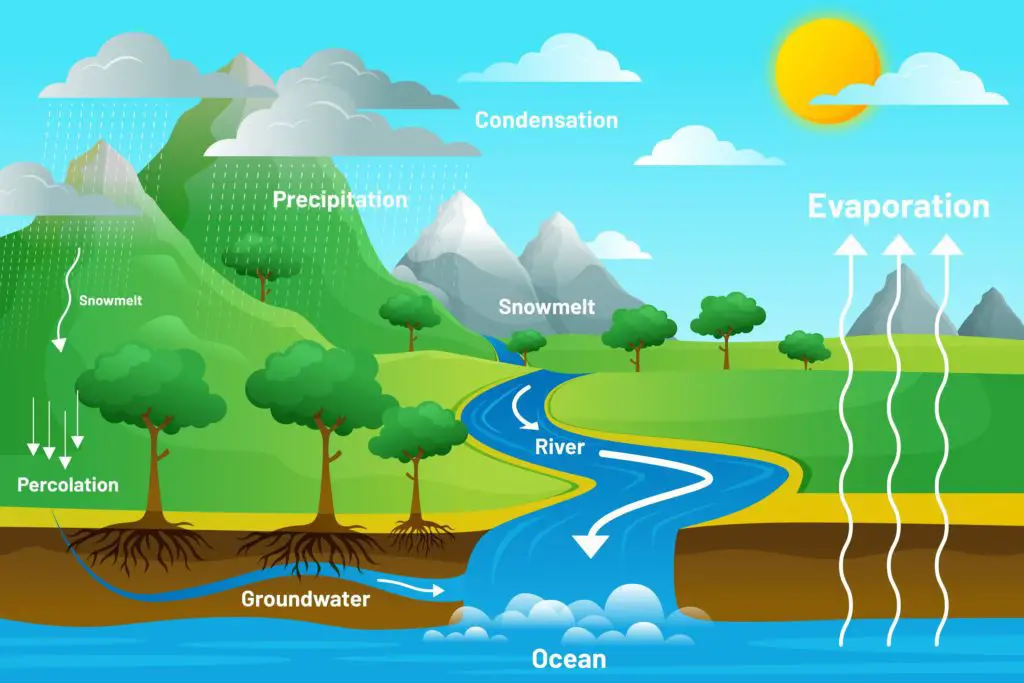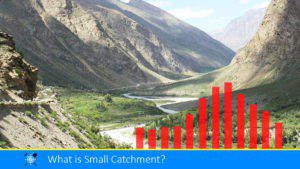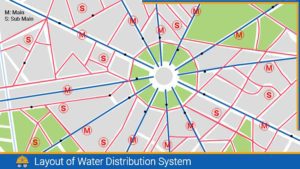The hydrologic cycle, also known as the water cycle, plays a crucial role in maintaining Earth’s water balance and supporting life on the planet. However, with the ongoing effects of climate change, this essential process is experiencing significant disruptions. In this article, we will delve into the intricate workings of the hydrologic cycle and explore the various ways in which climate change is affecting it. By understanding these impacts, we can better comprehend the broader implications for our environment and society.
The Hydrologic Cycle:
The hydrologic cycle consists of the following processes:

Evaporation and Transpiration:
Water from the Earth’s surface, including oceans, rivers, lakes, and moist soil, undergoes evaporation. This evaporation process converts water into water vapour, which is then transported over the land by the air, often forming clouds. Additionally, plants contribute to total evaporation through a process called transpiration, where water is lost from their leaves through tiny pores. Therefore, the overall evaporation, which includes both surface water evaporation and transpiration, comprises:
- Surface evaporation
- water surface evaporation: from river and ocean
- Evaporation from plants and leaves (known as transpiration)
- Atmospheric evaporation
Condensation:
Condensation is when water vapour changes into liquid water or solid ice. It happens when warm, moist air rises to higher altitudes where the temperature is lower. As the air rises, it expands and cools due to decreasing air pressure, causing the water vapour molecules to slow down and come closer together. This leads to the formation of tiny water droplets or ice crystals, which make up clouds. Factors like temperature, humidity, and the presence of cloud condensation nuclei (CCN) influence cloud formation. On average, the temperature decreases by about 6.5 degrees Celsius per kilometre of altitude.
When clouds form near the Earth’s surface, they are referred to as fog or mist. Clouds vary in size, shape, and composition. It’s important to note that condensation not only occurs in the atmosphere but also plays a vital role in various other natural processes. For example, dew formation on surfaces occurs when the temperature of an object drops below the dew point, causing the water vapour in the air to condense onto the object’s surface.
Precipitation:
As condensation continues in the atmosphere or clouds continue to develop and evolve, the water droplets within them undergo a process known as coalescence or collision and coalescence. During this process, the tiny water droplets in the clouds come closer and collide with each other, combining and forming larger droplets. As these droplets grow larger in size, they become too heavy to be held aloft by the air currents within the cloud.
Eventually, the force of gravity overcomes the upward (upthrust) air currents, causing the larger water droplets to fall from the cloud towards the Earth’s surface. This falling of water droplets from the clouds is known as precipitation.
Thus, precipitation may be defined as the fall of moisture from the atmosphere to the earth’s surface in any form. The form that precipitation takes depends on the atmospheric conditions as the droplets fall through different temperature layers in the atmosphere. Precipitation may be in two forms:
- Liquid precipitation: Rain is the only form of liquid precipitation which is the most common form of precipitation to reach the earth’s surface. Rain formation occurs when the temperature remains above freezing point throughout the descent of the droplets.
- Frozen precipitation: consists of
- Sleet: In colder regions, the temperature can be below freezing point at some levels of the atmosphere. In such cases, the water droplets freeze into ice crystals while still in the cloud. When these ice crystals fall towards the surface, they may pass through layers of warmer air, causing them to partially melt. The result is a form of precipitation known as sleet. Sleet consists of partially melted ice pellets that can bounce upon impact with the ground.
- Snow: In colder conditions, the ice crystals may not melt entirely and reach the surface as frozen particles. This frozen precipitation is commonly referred to as snow. Snowflakes are intricate ice crystals with unique shapes that vary based on temperature and humidity conditions during their formation.
- Hailstone: In certain weather conditions, such as thunderstorms, precipitation can take the form of hail. Hailstones are large ice pellets that are formed when water droplets in a storm cloud are carried upward into extremely cold regions, where they freeze and accumulate layers of ice. These hailstones can grow to significant sizes before eventually falling to the ground.
- Freezing rain: Freezing rain is a type of precipitation that occurs when raindrops fall through a layer of freezing air near the surface of the Earth. The raindrops, which are in a liquid state, encounter sub-freezing temperatures and freeze upon contact with objects and surfaces that are at or below freezing point. As it encounters the cold layer near the ground, the raindrops rapidly freeze, forming a coating of ice on exposed surfaces, such as roads, trees, power lines, and buildings.
RunOff:
Runoff encompasses the portion of precipitation that does not undergo evaporation. When moisture in the form of precipitation reaches the surface of the Earth, a fraction of it evaporates from water bodies, soil, and vegetation due to transpiration by plants. The remaining portion of precipitation, which is not lost through evaporation, becomes runoff. This runoff moves across the land, flowing through surface channels or seeping into the soil and travelling through sub-surface streams. Eventually, it converges and flows into the ocean through various pathways. Consequently, runoff can be categorized based on the following classifications:
- Surface runoff: This type of runoff occurs when precipitation exceeds the capacity of the soil to absorb it. It flows over the land surface, collecting in channels, streams, and rivers. Surface runoff is influenced by factors such as rainfall intensity, land cover, soil type, and the presence of natural or human-made drainage features.
- Sub-surface runoff: Sub-surface runoff also known as Interflow refers to the lateral movement of water through the soil or rock layers above the groundwater table. It occurs when the soil becomes saturated and excess water moves laterally along a relatively impermeable layer, such as a clay or rock layer, before reaching a surface water body or recharging groundwater.
- Base flow: It is also known as groundwater flow as the portion of runoff that comes from groundwater seeping into streams and rivers, which after infiltration, percolates down and joins the groundwater reservoir which is ultimately connected to the ocean.
- Overland Flow: Overland flow, also known as sheet flow, happens when rainfall intensity is high, or the soil’s infiltration capacity is low, resulting in water flowing over the surface in a thin sheet rather than infiltrating into the soil.
- Channel Flow: Channel flow refers to the movement of water within established river channels or streams. It occurs when the volume of runoff exceeds the capacity of overland flow and flows within well-defined channels, influenced by the topography and characteristics of the channel itself.
In Summary:
The hydrologic cycle can be expressed by the following equation
Precipitation = Evaporation + Runoff
References:
- Punima B., Lal. Pade B.B, Jain Ashok Kumar & Jain Arun Kumar (2009). Irrigation and Water Power Engineering. Laxmi Publication (P) Ltd.
- Garg, S.K. (2010). Environmental Engineering. Vol.-I. Water Supply Engineering (35th ed.). Khanna Publishers. Daryaganj, New Delhi-110002.
Also, read:
- What is Small Catchment?
- Types of Water Demand
- Water Quality Parameters: Importance of Quality of Water?
![]()







